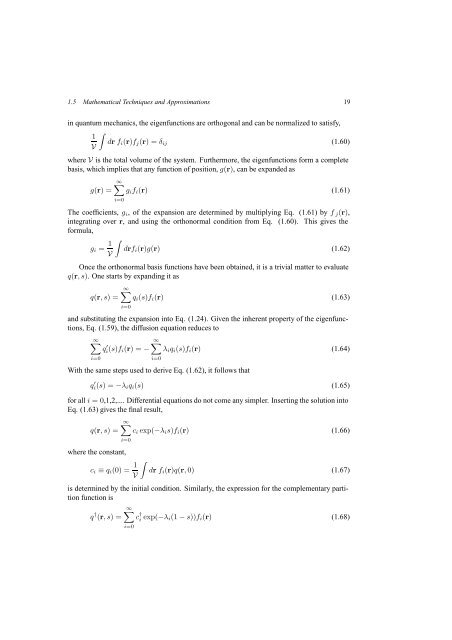Self-Consistent Field Theory and Its Applications by M. W. Matsen
Self-Consistent Field Theory and Its Applications by M. W. Matsen
Self-Consistent Field Theory and Its Applications by M. W. Matsen
Create successful ePaper yourself
Turn your PDF publications into a flip-book with our unique Google optimized e-Paper software.
1.5 Mathematical Techniques <strong>and</strong> Approximations 19<br />
in quantum mechanics, the eigenfunctions are orthogonal <strong>and</strong> can be normalized to satisfy,<br />
∫<br />
1<br />
dr f i (r)f j (r) =δ ij (1.60)<br />
V<br />
where V is the total volume of the system. Furthermore, the eigenfunctions form a complete<br />
basis, which implies that any function of position, g(r), can be exp<strong>and</strong>ed as<br />
g(r) =<br />
∞∑<br />
g i f i (r) (1.61)<br />
i=0<br />
The coefficients, g i , of the expansion are determined <strong>by</strong> multiplying Eq. (1.61) <strong>by</strong> f j (r),<br />
integrating over r, <strong>and</strong> using the orthonormal condition from Eq. (1.60). This gives the<br />
formula,<br />
g i = 1 ∫<br />
drf i (r)g(r) (1.62)<br />
V<br />
Once the orthonormal basis functions have been obtained, it is a trivial matter to evaluate<br />
q(r,s). One starts <strong>by</strong> exp<strong>and</strong>ing it as<br />
q(r,s)=<br />
∞∑<br />
q i (s)f i (r) (1.63)<br />
i=0<br />
<strong>and</strong> substituting the expansion into Eq. (1.24). Given the inherent property of the eigenfunctions,<br />
Eq. (1.59), the diffusion equation reduces to<br />
∞∑<br />
∞∑<br />
q i ′ (s)f i(r) =− λ i q i (s)f i (r) (1.64)<br />
i=0<br />
i=0<br />
With the same steps used to derive Eq. (1.62), it follows that<br />
q ′ i(s) =−λ i q i (s) (1.65)<br />
for all i =0,1,2,.... Differential equations do not come any simpler. Inserting the solution into<br />
Eq. (1.63) gives the final result,<br />
q(r,s)=<br />
∞∑<br />
c i exp(−λ i s)f i (r) (1.66)<br />
i=0<br />
where the constant,<br />
c i ≡ q i (0) = 1 ∫<br />
V<br />
dr f i (r)q(r, 0) (1.67)<br />
is determined <strong>by</strong> the initial condition. Similarly, the expression for the complementary partition<br />
function is<br />
∞∑<br />
q † (r,s)= c † i exp(−λ i(1 − s))f i (r) (1.68)<br />
i=0
















